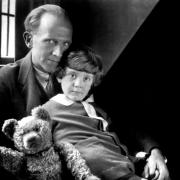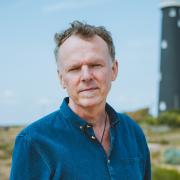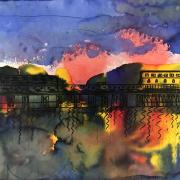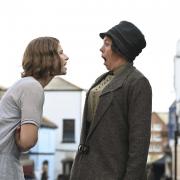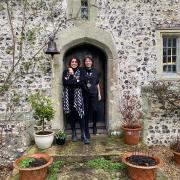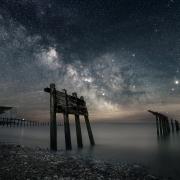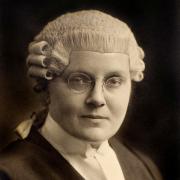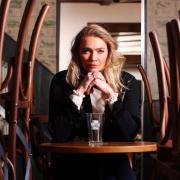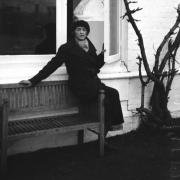The West Sussex painter has spent nearly his entire life making art, much of it in the studio built by his father, Ivon Hitchens

One might expect to find John Hitchens in a reflective mood. This year marks the artist’s 80th on the planet and he has a new retrospective open at Southampton City Art Gallery spanning more than seven decades.
But the frenetic creativity that has fuelled his career thus far remains undiminished; he has little time for looking back when there is still much to be done in the present.
In his warren of a studio, hidden away in ferny woodland outside Petworth, the shelves are packed with notebooks of ideas yet to be realised. “I’ll never run out,” he says, eyes bright behind thin-framed glasses. “But I may run out of time.” So far from scaling back, he intends to scale up, launching into his largest painting to date this winter.
His work has been getting progressively larger for years now and several of the paintings on show at Southampton run across multiple panels. “You have a different physical relationship to the canvas the larger it is. You look up to the painting rather than down on it. It changes your perspective.”

Hitchens has spent nearly his entire life making art, much of it in this same patch of West Sussex. His father, the painter Ivon Hitchens (himself the son of the Victorian painter Alfred Hitchens), moved into a caravan here when he was bombed out of his home in 1940.
He later built the studio where his son still works today, each room now an Aladdin’s cave of canvases, sketchbooks, found objects and curious creations.
It was his father who presented him with his first paint box aged nine; “That was when I did my first ever oil painting. I loved [oils] immediately.” He never decided to become a painter - perhaps one never does. “I just did it.” Neither did he hesitate in choosing his subject matter.
For as long as he has been able to paint, he has painted the landscapes of the South Downs and West Sussex, from the top of Duncton Hill to the beaches of Selsey.

Like the pine trees outside the window, Hitchens’ roots coil deep down in this soil and, despite spells working in Wales and in Scotland, he has always found himself drawn back here.
It is not an emotional pull so much as an intellectual one, he explains. He is interested in the way the landscape contrasts with that of the rest of the UK, what distinguishes it as Sussex. “Wales and Scotland are all raw stuff, rocks and space, then you come back to West Sussex and there are all these trees, all this jungle-y growth. It used to come as quite a shock when I returned.”
MORE: Sussex artist Robert Tavener celebrated in a new exhibition in Eastbourne
Hitchens’ early work in the 1960s was all made outdoors; when he worked on the coast he would pull his paints along in an apple box attached to an old pram chassis. Otherwise, his Land Rover served as a mobile studio.

“My early work was very quick, very instinctive,” he says, rifling through a pile of canvases of eloquent, spare brushwork evoking scudding clouds or rough waves. “There was no question of spending a lot of time, I would decide when it was finished and move on.” It’s a different story today, when he will spend weeks on one painting.
His work is made in the studio now and characterised by intricate patterns and abstract shapes inspired by rock formations, plough lines and field boundaries – the same handwriting but a different language.
The move away from pictorial landscapes was not planned and is still not understood by some collectors, who prefer his early work. “I found I was getting rid of all the things I was good at doing, things I felt I’d mastered, and moving into areas that were more challenging to me, and therefore more interesting,” he explains.
By the 1990s he had developed a great interest in aerial photography, heading up into the sky in light aircraft to view familiar landscapes from an entirely different viewpoint. He had been painting Duncton Hill for years and had always liked the way the skyline met the sea and the edge of the hill.

But as time went on, he felt increasingly that the clouds seemed to dominate the land and to counter this, he began to edge them out of his paintings. “The sky got less and less until it was just an indication that this wasn’t an abstract painting.”
Eventually, he dispensed with it altogether to focus entirely on the land. It was the beginning of the style he is known for today. It appeared to be a dramatic change of aesthetic, yet it has its roots in Hitchens’ early work.
One of the earliest paintings in the Southampton exhibition is a bold, partly impressionistic depiction of a bouquet of flowers sent to mark the birth of his first son, Simon, in 1967. “There’s never been a stage I’ve moved on from that [style]. I’ve just carried all the best ideas forwards into new formats.”
Today, Simon continues the family’s artistic legacy as a celebrated sculptor; last year Petworth’s Kevis House Gallery staged an exhibition of his work alongside that of his father, great-grandfather and great-great-grandfather.
It must be an incredible gift, I suggest, to be accompanied throughout one’s life by the drive to create – to remain fired up even at an age when many find themselves beginning to wind down.
Hitchens agrees, and says he often thinks of how orchestra conductors supposedly live longer than average. “They must be half-deafened but they do tend to live a long time and I think that’s partly because they remain excited about what they are doing. I hope that’s going to prove the case for me.”
John Hitchens; Aspects of Landscape is at Southampton City Art Gallery until 3 October and can also be viewed online. John Hitchens: Aspects of Landscape by Caroline Collier (Sansom and Company, hardback £45) is the first book about John Hitchens’ work
Join the conversation on our Facebook, Twitter and Instagram pages





